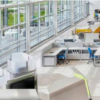As cubicle farms and enclosed offices dissolved into unassigned seating areas and shared workstations over the past decade, employers looked to usher in a new era of workplace collaboration – and unlock real estate cost savings.
But in many cases, companies encountered less-than-optimal results. Initially, technology – namely Wi-Fi networks as well as mobile and portable devices – were insufficiently widespread to support this new approach to commercial real estate. Elsewhere, particularly in government, workstations failed to reflect the varied nature of the tasks performed by employees each day.
“Space optimization took (the commercial real estate industry) down a path of easy planning,” said Real Strategy CEO Darren Fleming, mentioning it frequently involved too much standardization and was all too often viewed as a cost-reduction strategy.
OBJ360 (Sponsored)

Canada’s judge shortage doesn’t have to negatively impact your family – or your business
Arbitration has always been a critical part of Canada’s legal system, but lately it has been getting more attention due to the judge shortage.

Vegan? Halal? Gluten-free? This Ottawa restaurant has you covered
For food lovers who have dietary restrictions, it can often be a challenge to find a restaurant that checks all the boxes.
“The pendulum swung too far,” he added.
Within the federal government, many employees struggled with the changes. Nearly four out of five respondents to a 2018 survey by the Professional Institute of the Public Service of Canada said they were having greater difficulty concentrating in the more open layout. Additionally, 62 per cent reported lower productivity rates.
“There are workers who are ready to work in an open environment,” said PIPSC vice-president Sean O’Reilly. “But everyone’s different, and they need different ways to work.”
That message is increasingly resonating with real estate officials both within the federal government and the private sector and is reflected in new and more flexible approaches.
Agile working, activity-based workplaces and – in the federal government – GC Workplaces all aim to put employees first by providing them with control over where they spend their time.
Staff have the chance to collaborate on comfy couches, work solo at an unassigned desk or concentrate in a quiet space. Digital storage, wireless networks as well as mobile telephony and computing enable employees to seamlessly move between spaces during the day.
Consulting firm Deloitte said in a 2017 report that these real estate and technology strategies should be accompanied by an HR rethink that includes culture and change management.
Bob Perkins, an Ottawa-based vice-president in Deloitte’s real estate advisory practice, said trust is a major part of the equation. He noted that on many days, he doesn’t know if his colleagues are working from home, on vacation or out meeting clients when they’re not in the office.
“If you’re accountable for your work, no matter where you are, it works,” he said.

The landlord’s role
While this new office environment requires significant buy-in from tenants, employers and workspace consultants, landlords and property managers also have an important role to play as enablers.
“Tenants are no longer willing to tweak an old space and live with it,” Fleming says. “They are willing to pay a premium for really cool space that doesn’t require a lot of upfront costs but still looks like a photo from a magazine.”
He suggests rethinking “base building” finishes to include meeting facilities and kitchens that can be repositioned as tenants turn over. He acknowledges that landlords only have so much money to put into leasehold improvements on a standard five- or 10-year term while keeping rents reasonable, but believes creative financing options with furnishing manufacturers can be part of the solution.
“You need to trust that the tenants are out there, that they desire the premium space and are willing to pay the higher rent,” he says. “The alternative is vacancies.”
Traditional vs. agile workspaces
| Agile | Rigid |
| Shared use, anywhere, anytime | 9-to-5 hours, assigned workspaces |
|
Trust and collaboration |
Command and control hierarchy |
|
Paper independent, electronic document storage |
Paper dependent |
|
Constant collaboration on multiple dimensions |
Linear processes |
|
Wireless, networked |
Hard wired |
Source: Deloitte





